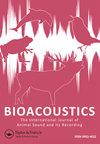Evidence of signature whistles produced by Indian Ocean bottlenose dolphins (Tursiops aduncus) in Mozambique
IF 2.1
4区 生物学
Q2 ZOOLOGY
Bioacoustics-The International Journal of Animal Sound and Its Recording
Pub Date : 2023-07-05
DOI:10.1080/09524622.2023.2229290
引用次数: 0
Abstract
ABSTRACT Individually distinctive signature whistles are used by common bottlenose dolphins (Tursiops truncatus) during social interactions and to facilitate group cohesion. There is evidence from a few populations that Indian Ocean bottlenose dolphins (T. aduncus) also use signature whistles. We investigated this from a coastal resident population of T. aduncus in Mozambique. Video-audio data were collected during recreational swim-with activities over 12 years, where potential signature whistles were identified from 28 individuals. Of the 405 whistles documented, 75% were produced in SIGID bouts. Visual assessment of individual signature whistle contours demonstrated temporal stability for up to 8 years. Overall, most signature whistle types had upsweep frequency modulation and were emitted as multiloop whistles. Comparing all whistle contours to each other indicated low discrimination between individuals, with contours frequently categorised together. However, sex differences in the frequency characteristics of whistles were identified, with females whistling at lower frequencies than males. Our results indicate either a shared whistle repertoire or identity encoding with subtle contour features, requiring acute auditory perception and discrimination to decipher caller identity. More widespread geographic investigation into signature whistle use may demonstrate variation in acoustic communication systems for bottlenose dolphins, which are thus far not well understood.印度洋宽吻海豚(Tursiops aduncus)在莫桑比克发出的标志性哨声证据
常见的宽吻海豚(Tursiops truncatus)在社会交往中使用独特的签名哨声,以促进群体凝聚力。有证据表明,印度洋宽吻海豚(T. aduncus)也使用标志性的哨声。我们从莫桑比克的沿海常住人口中调查了这一点。在12年的休闲游泳活动中收集视频音频数据,从28个人中识别出潜在的签名哨声。在记录在案的405个哨声中,75%是在SIGID回合中产生的。个人签名哨子轮廓的视觉评估显示了长达8年的时间稳定性。总体而言,大多数签名哨声类型具有上扫频率调制,并作为多环路哨声发射。将所有哨子轮廓相互比较表明个体之间的歧视程度较低,轮廓经常被归类在一起。然而,哨声的频率特征存在性别差异,女性的哨声频率低于男性。我们的研究结果表明,要么是共同的哨音曲目,要么是具有微妙轮廓特征的身份编码,需要敏锐的听觉感知和辨别来破译呼叫者身份。对签名哨子的使用进行更广泛的地理调查,可能会证明宽吻海豚的声学通信系统存在差异,这一点迄今为止还没有得到很好的理解。
本文章由计算机程序翻译,如有差异,请以英文原文为准。
求助全文
约1分钟内获得全文
求助全文
来源期刊
CiteScore
4.50
自引率
0.00%
发文量
25
审稿时长
>12 weeks
期刊介绍:
Bioacoustics primarily publishes high-quality original research papers and reviews on sound communication in birds, mammals, amphibians, reptiles, fish, insects and other invertebrates, including the following topics :
-Communication and related behaviour-
Sound production-
Hearing-
Ontogeny and learning-
Bioacoustics in taxonomy and systematics-
Impacts of noise-
Bioacoustics in environmental monitoring-
Identification techniques and applications-
Recording and analysis-
Equipment and techniques-
Ultrasound and infrasound-
Underwater sound-
Bioacoustical sound structures, patterns, variation and repertoires

 求助内容:
求助内容: 应助结果提醒方式:
应助结果提醒方式:


